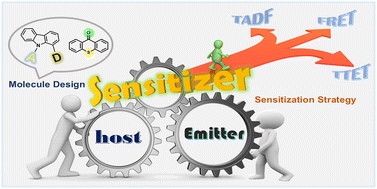As a class of functional materials used in organic light-emitting diodes (OLEDs), sensitizers play a crucial role in the improvement of device efficiency, color purity, and stability. In recent years, thermally activated delayed fluorescence (TADF) sensitizers have attracted much attention mainly because of their high exciton utilization efficiency by converting quenched triplet excitons into singlet excitons. Despite the experimental success of sensitization strategies in enhancing OLED performance, the lack of theoretical models for sensitizers continues to hinder further development. In the present work, we design three novel sensitizers and investigate their photophysical mechanisms in the presence of a host and/or an emitter. Based on highly accurate electronic structure calculations and non-radiative transition rates, we propose the first theoretical model to describe the dynamic behavior of sensitizers in OLEDs. This model highlights key factors for achieving ultraefficient sensitization, such as multi-channel energy transfer capabilities, large intermolecular electronic couplings, and reduced redundant energy transfer pathways in devices as well as conformational rigidity under excitation and small singlet–triplet energy splitting for ideal sensitizers. In particular, a binary system consisting of a new sensitizer as the host material and an emitter achieves excellent performance with a high external quantum efficiency of 29.2% and negligible efficiency roll-off of 5.5% at a brightness of 1000 cd m−2 for red phosphorescent OLEDs. These findings provide fundamental chemical insights into exciton dynamics and practical guidelines for material-device co-optimization in next-generation electroluminescent technologies.


